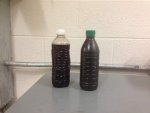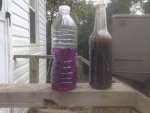Below may help:
[FONT="][FONT=Arial,Helvetica]DOT3[/FONT][/FONT]
[FONT="][FONT=Arial,Helvetica][SIZE=-1] DOT3 brake fluid is the "conventional" brake fluid used in most vehicles.[/SIZE][/FONT][/FONT]
[FONT="][FONT=Arial,Helvetica][SIZE=-1] Advantages:[/SIZE][/FONT][/FONT]
[FONT="][FONT=Arial,Helvetica][SIZE=-1] DOT3 fluid is inexpensive, and available at most gas stations, department stores, and any auto parts store.[/SIZE][/FONT][/FONT]
[FONT="][FONT=Arial,Helvetica][SIZE=-1] Disadvantages:[/SIZE][/FONT][/FONT]
[FONT="][FONT=Arial,Helvetica][SIZE=-1] DOT3 fluid eats paint![/SIZE][/FONT]
[FONT=Arial,Helvetica][SIZE=-1] DOT3 fluid absorbs water very readily. (This is often referred to as being hydroscopic.) As such, once a[/SIZE][/FONT]
[FONT=Arial,Helvetica][SIZE=-1] container of DOT3 has been opened, it should not be stored for periods much longer than a week before use.[/SIZE][/FONT]
[FONT=Arial,Helvetica][SIZE=-1] Since DOT3 fluid absorbs water, any moisture absorbed by the fluid can encourage corrosion in the brake lines[/SIZE][/FONT]
[FONT=Arial,Helvetica][SIZE=-1] and cylinders.[/SIZE][/FONT][/FONT]
[FONT="][FONT=Arial,Helvetica]DOT4[/FONT][/FONT]
[FONT="][FONT=Arial,Helvetica][SIZE=-1] DOT4 brake fluid is the brake fluid suggested for use in some late model cars.[/SIZE][/FONT][/FONT]
[FONT="][FONT=Arial,Helvetica][SIZE=-1] Advantages:[/SIZE][/FONT][/FONT]
[FONT="][FONT=Arial,Helvetica][SIZE=-1] DOT4 fluid is available at most auto parts stores, and at some (but not all) gas stations or department stores.[/SIZE][/FONT]
[FONT=Arial,Helvetica][SIZE=-1] DOT4 fluid does not absorb water as readily as DOT3 fluid.[/SIZE][/FONT]
[FONT=Arial,Helvetica][SIZE=-1] DOT4 fluid has a higher boiling point than DOT3 fluid, making it more suitable for high performance applications[/SIZE][/FONT]
[FONT=Arial,Helvetica][SIZE=-1] where the brake systems are expected to get hot.[/SIZE][/FONT][/FONT]
[FONT="][FONT=Arial,Helvetica][SIZE=-1] Disadvantages:[/SIZE][/FONT][/FONT]
[FONT="][FONT=Arial,Helvetica][SIZE=-1] DOT4 fluid eats paint! Small leaks around the master cylinder will eventually dissolve away the paint on your[/SIZE][/FONT]
[FONT=Arial,Helvetica][SIZE=-1] bodywork in the general vicinity of the leak, and then give rust a chance to attack the body of your car![/SIZE][/FONT]
[FONT=Arial,Helvetica][SIZE=-1] DOT4 fluid is generally about 50% more expensive than DOT3 fluid.[/SIZE][/FONT]
[FONT=Arial,Helvetica][SIZE=-1] Since DOT4 fluid still absorbs some water, any moisture absorbed by the fluid can encourage corrosion in the[/SIZE][/FONT]
[FONT=Arial,Helvetica][SIZE=-1] brake lines and cylinders.[/SIZE][/FONT][/FONT]
[FONT="][FONT=Arial,Helvetica]DOT5[/FONT][/FONT]
[FONT="][FONT=Arial,Helvetica][SIZE=-1] DOT5 brake fluid is also known as "silicone" brake fluid.[/SIZE][/FONT][/FONT]
[FONT="][FONT=Arial,Helvetica][SIZE=-1] Advantages:[/SIZE][/FONT][/FONT]
[FONT="][FONT=Arial,Helvetica][SIZE=-1] DOT5 doesn't eat paint.[/SIZE][/FONT]
[FONT=Arial,Helvetica][SIZE=-1] DOT5 does not absorb water and may be useful where water absorption is a problem.[/SIZE][/FONT]
[FONT=Arial,Helvetica][SIZE=-1] DOT5 is compatible with all rubber formulations. (See more on this under disadvantages, below.)[/SIZE][/FONT][/FONT]
[FONT="][FONT=Arial,Helvetica][SIZE=-1] Disadvantages:[/SIZE][/FONT][/FONT]
[FONT="][FONT=Arial,Helvetica][SIZE=-1] DOT5 does NOT mix with DOT3, DOT4 or DOT5.1. Most reported problems with DOT5 are probably due to some[/SIZE][/FONT]
[FONT=Arial,Helvetica][SIZE=-1] degree of mixing with other fluid types. The best way to convert to DOT5 is to totally rebuild the hydraulic[/SIZE][/FONT]
[FONT=Arial,Helvetica][SIZE=-1] system.[/SIZE][/FONT]
[FONT=Arial,Helvetica][SIZE=-1] Reports of DOT5 causing premature failure of rubber brake parts were more common with early DOT5[/SIZE][/FONT]
[FONT=Arial,Helvetica][SIZE=-1] formulations. This is thought to be due to improper addition of swelling agents and has been fixed in recent[/SIZE][/FONT]
[FONT=Arial,Helvetica][SIZE=-1] formulations.[/SIZE][/FONT]
[FONT=Arial,Helvetica][SIZE=-1] Since DOT5 does not absorb water, any moisture in the hydraulic system will "puddle" in one place. This can[/SIZE][/FONT]
[FONT=Arial,Helvetica][SIZE=-1] cause localized corrosion in the hydraulics.[/SIZE][/FONT]
[FONT=Arial,Helvetica][SIZE=-1] Careful bleeding is required to get all of the air out of the system. Small bubbles can form in the fluid that will form[/SIZE][/FONT]
[FONT=Arial,Helvetica][SIZE=-1] large bubbles over time. It may be necessary to do a series of bleeds.[/SIZE][/FONT]
[FONT=Arial,Helvetica][SIZE=-1] DOT5 is slightly compressible (giving a very slightly soft pedal), and has a lower boiling point than DOT4.[/SIZE][/FONT]
[FONT=Arial,Helvetica][SIZE=-1] DOT5 is about twice as expensive as DOT4 fluid. It is also difficult to find, generally only available at selected[/SIZE][/FONT]
[FONT=Arial,Helvetica][SIZE=-1] auto parts stores.[/SIZE][/FONT][/FONT]
[FONT="][FONT=Arial,Helvetica]DOT5.1[/FONT][/FONT]
[FONT="][FONT=Arial,Helvetica][SIZE=-1] DOT5.1 is a relatively new brake fluid that is causing no end of confusion amongst mechanics. The DOT could avoid a[/SIZE][/FONT]
[FONT=Arial,Helvetica][SIZE=-1] lot of confusion by giving this new fluid a different designation. The 5.1 designation could lead one to believe that it's a[/SIZE][/FONT]
[FONT=Arial,Helvetica][SIZE=-1] modification of silicone-based DOT 5 brake fluid. Calling it 4.1 or 6 might have been more appropriate since it's a[/SIZE][/FONT]
[FONT=Arial,Helvetica][SIZE=-1] glycol-based fluid like the DOT 3 and 4 types, not silicone-based like DOT 5 fluid.[/SIZE][/FONT][/FONT]
[FONT="][FONT=Arial,Helvetica][SIZE=-1] As far as the basic behavior of 5.1 fluids, they are much like "high performance" DOT4 fluids, rather than traditional[/SIZE][/FONT]
[FONT=Arial,Helvetica][SIZE=-1] DOT5 brake fluids.[/SIZE][/FONT][/FONT]
[FONT="][FONT=Arial,Helvetica][SIZE=-1] Advantages:[/SIZE][/FONT][/FONT]
[FONT="][FONT=Arial,Helvetica][SIZE=-1] DOT5.1 provides superior performance over the other brake fluids discussed here. It has a higher boiling point,[/SIZE][/FONT]
[FONT=Arial,Helvetica][SIZE=-1] either dry or wet, than DOT 3 or 4. In fact, its dry boiling point (about 275 degrees C) is almost as high as racing[/SIZE][/FONT]
[FONT=Arial,Helvetica][SIZE=-1] fluid (about 300 degrees C) and 5.1's wet boiling point (about 175 to 200 degrees C) is naturally much higher[/SIZE][/FONT]
[FONT=Arial,Helvetica][SIZE=-1] than racing's (about 145 C).[/SIZE][/FONT]
[FONT=Arial,Helvetica][SIZE=-1] DOT5.1 is said to be compatible with all rubber formulations.[/SIZE][/FONT][/FONT]
[FONT="][FONT=Arial,Helvetica][SIZE=-1] Disadvantages:[/SIZE][/FONT][/FONT]
[FONT="][FONT=Arial,Helvetica][SIZE=-1] DOT5.1 fluids (and Spectro's Supreme DOT4) are non-silicone fluids and will absorb water.[/SIZE][/FONT]
[FONT=Arial,Helvetica][SIZE=-1] DOT5.1 fluids, like DOT3 & DOT4 will eat paint.[/SIZE][/FONT]
[FONT=Arial,Helvetica][SIZE=-1] DOT 5.1 fluids are difficult to find for sale, typically at very few auto parts stores, mostly limited to "speed shops."[/SIZE][/FONT]
[FONT=Arial,Helvetica][SIZE=-1] DOT 5.1 will be more expensive than DOT3 or DOT4, and more difficult to find.[/SIZE][/FONT][/FONT]




